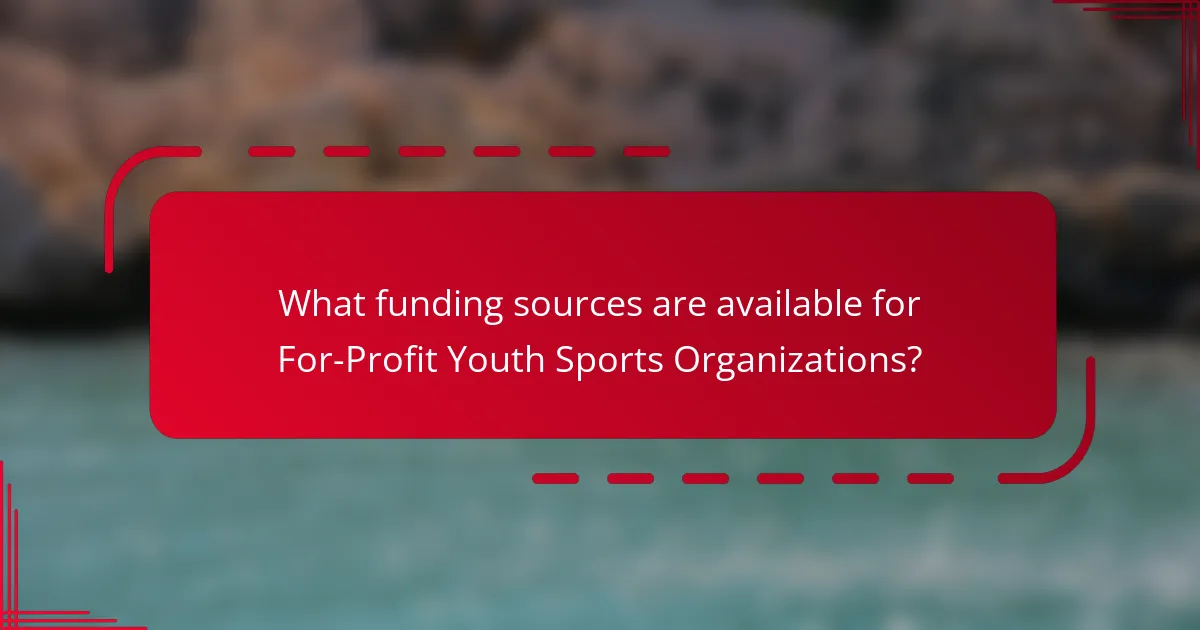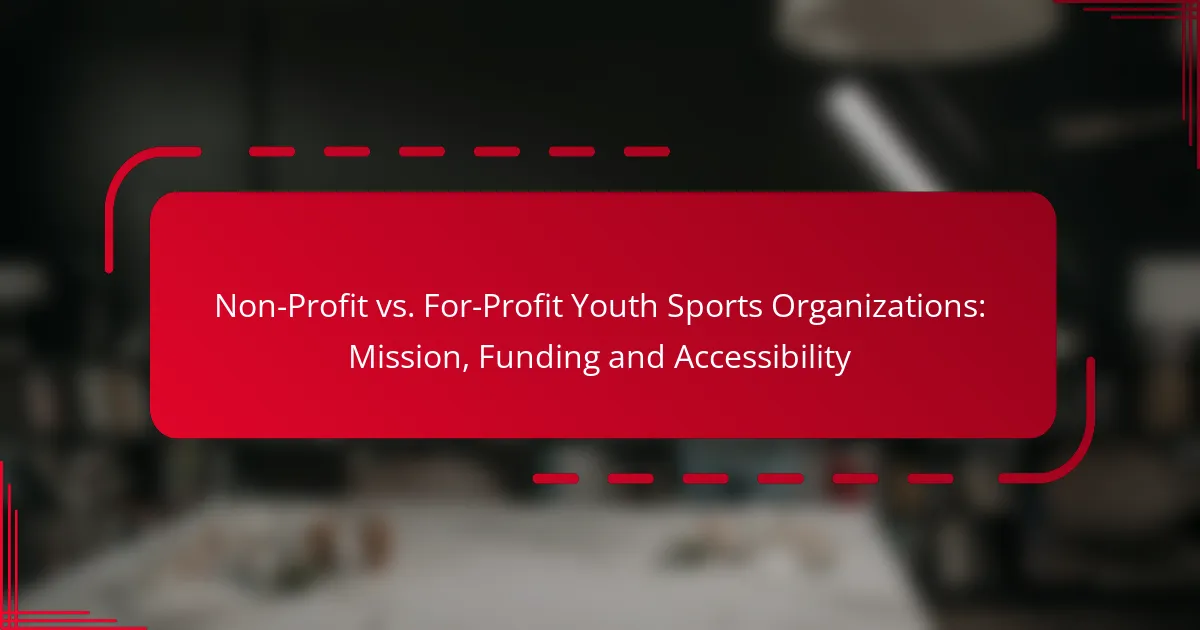The landscape of youth sports organizations is shaped by the fundamental differences between non-profit and for-profit entities, particularly in their mission, funding sources, and accessibility. Non-profit organizations prioritize community benefit and inclusivity, while for-profit organizations focus on generating profit, which can sometimes limit accessibility for participants. Understanding these distinctions is crucial for stakeholders seeking to navigate the youth sports environment effectively.

What are the key differences between Non-Profit and For-Profit Youth Sports Organizations?
The primary differences between non-profit and for-profit youth sports organizations lie in their mission, funding sources, and accessibility. Non-profits focus on community benefit and inclusivity, while for-profits aim to generate profit and may prioritize financial sustainability over accessibility.
Mission focus of Non-Profit organizations
Non-profit youth sports organizations are dedicated to promoting youth development, teamwork, and community engagement. Their mission often emphasizes inclusivity, ensuring that all children, regardless of their financial situation, have access to sports programs.
These organizations typically reinvest any surplus funds back into their programs, enhancing facilities, providing scholarships, or expanding outreach efforts. For example, a non-profit might offer free or reduced-cost clinics to underprivileged youth, fostering a sense of belonging and personal growth.
Mission focus of For-Profit organizations
For-profit youth sports organizations primarily focus on generating revenue and maximizing profits. Their mission often centers on providing high-quality training and competitive opportunities, which can attract families willing to pay for premium services.
These organizations may offer specialized training programs, elite teams, and advanced facilities, but they often charge higher fees. For instance, a for-profit sports academy might require significant tuition for participation, potentially limiting access for lower-income families.
Comparison of organizational goals
The goals of non-profit and for-profit youth sports organizations differ significantly. Non-profits prioritize community service, youth engagement, and accessibility, often seeking grants and donations to fund their initiatives.
In contrast, for-profits focus on financial viability and customer satisfaction, aiming to attract paying clients through marketing and high-quality offerings. This can lead to a competitive environment where success is measured by profitability rather than community impact.
Ultimately, families should consider their values and priorities when choosing between these types of organizations. Non-profits may provide more inclusive options, while for-profits might offer specialized training and competitive advantages.

How do Non-Profit Youth Sports Organizations secure funding?
Non-profit youth sports organizations secure funding through a variety of channels, primarily focusing on grants, donations, fundraising events, and community sponsorships. These methods allow them to operate without the profit motive, ensuring that funds are directed towards enhancing youth sports accessibility and development.
Grants and donations
Grants and donations are vital for non-profit youth sports organizations, often coming from government bodies, foundations, and private individuals. Organizations typically apply for grants that align with their mission, which can range from a few thousand to several hundred thousand dollars, depending on the grantor’s funding capacity.
Donations can be solicited through campaigns that highlight the organization’s impact on the community. Many organizations set up online platforms to facilitate easy contributions, which can significantly increase their funding base.
Fundraising events
Fundraising events are a popular way for non-profit youth sports organizations to generate revenue while engaging the community. Common events include charity tournaments, bake sales, and auctions, which can raise anywhere from a few hundred to several thousand dollars, depending on participation and sponsorship.
Effective planning is crucial for these events. Organizations should set clear goals, promote the event widely, and consider partnerships with local businesses to enhance visibility and support.
Community sponsorships
Community sponsorships involve local businesses or individuals providing financial support in exchange for advertising opportunities or community goodwill. This can include sponsoring uniforms, equipment, or facilities, which helps reduce operational costs for the organization.
Building strong relationships with sponsors is essential. Organizations should communicate the benefits of sponsorship, such as brand exposure and community engagement, to attract and retain sponsors effectively.

What funding sources are available for For-Profit Youth Sports Organizations?
For-profit youth sports organizations typically rely on various funding sources to sustain their operations and provide quality programs. Key funding avenues include tuition and fees, corporate sponsorships, and merchandising and sales, each contributing to the overall financial health of the organization.
Tuition and fees
Tuition and fees are primary revenue sources for for-profit youth sports organizations. These charges often cover participation costs, training sessions, and facility usage. Organizations may set fees based on the level of competition, age group, and duration of the season, typically ranging from a few hundred to several thousand dollars annually.
When determining tuition, organizations should consider local market rates and the financial capabilities of families. Offering tiered pricing or scholarships can help increase accessibility while maintaining revenue.
Corporate sponsorships
Corporate sponsorships provide significant funding opportunities for for-profit youth sports organizations. Businesses often seek to enhance their community presence and brand visibility by sponsoring teams or events. In return, they may receive advertising space on uniforms, banners, or promotional materials.
Organizations should actively pursue sponsorships by creating attractive proposals that outline potential benefits for sponsors. Building relationships with local businesses can lead to long-term partnerships that provide consistent financial support.
Merchandising and sales
Merchandising and sales can be lucrative for for-profit youth sports organizations, allowing them to generate additional revenue through branded apparel and equipment. Selling items such as jerseys, hats, and training gear not only boosts income but also fosters team spirit and community engagement.
Organizations should consider setting up online stores or partnering with local retailers to expand their reach. Seasonal sales events or promotions can further enhance merchandise sales, making it a valuable funding source.

How do accessibility and participation differ between Non-Profit and For-Profit organizations?
Accessibility and participation in youth sports vary significantly between non-profit and for-profit organizations. Non-profits often prioritize inclusivity and affordability, while for-profits may focus on revenue generation, which can impact participation rates and accessibility for lower-income families.
Affordability in Non-Profit programs
Non-profit youth sports programs typically offer lower fees compared to for-profit organizations, making them more accessible to families with limited financial resources. Many non-profits rely on donations, grants, and community support to subsidize costs, which can result in fees that are often in the low hundreds of USD per season.
Additionally, non-profits may provide scholarships or sliding scale fees based on income, ensuring that children from diverse backgrounds can participate. This approach fosters community engagement and encourages a wider range of participants.
Accessibility initiatives in For-Profit programs
For-profit youth sports organizations often implement specific initiatives to enhance accessibility, such as offering flexible payment plans or discounts for early registration. These strategies can make participation more feasible for families, although the overall costs may still be higher than non-profit options.
Some for-profits also partner with local businesses or sponsors to provide scholarships or reduced fees for underprivileged youth. However, the emphasis on profit can sometimes limit the extent of these initiatives, making it essential for parents to research available options thoroughly.

What are the benefits of Non-Profit Youth Sports Organizations?
Non-profit youth sports organizations offer several advantages, including community support, a focus on youth development, and accessible programs. These organizations typically prioritize their mission over profit, which can lead to more inclusive and affordable opportunities for young athletes.
Community engagement
Non-profit youth sports organizations often foster strong community ties by involving local families, businesses, and volunteers. This engagement can result in increased participation and support, as community members feel invested in the success of the programs.
Additionally, these organizations frequently host events and fundraisers that bring people together, enhancing local relationships and promoting a sense of belonging. For example, a non-profit soccer league might organize community tournaments that not only showcase young talent but also raise funds for local charities.
Focus on youth development
Non-profit youth sports organizations emphasize the holistic development of young athletes, prioritizing skills, teamwork, and personal growth over competition. This approach helps children build confidence, resilience, and social skills that extend beyond the playing field.
Programs are often designed to cater to various skill levels, ensuring that all participants can benefit from the experience. Coaches and volunteers are typically trained to focus on positive reinforcement and mentorship, which can significantly impact a child’s self-esteem and overall well-being.

What advantages do For-Profit Youth Sports Organizations offer?
For-profit youth sports organizations provide several advantages, including enhanced resources, specialized training, and a focus on competitive performance. These organizations often have the flexibility to invest in facilities, coaching staff, and marketing, which can lead to a more polished experience for participants.
Access to Better Facilities
For-profit youth sports organizations typically have access to superior facilities compared to their non-profit counterparts. This includes well-maintained fields, gyms, and equipment that can enhance the training and playing experience for young athletes. The investment in facilities can lead to a more professional atmosphere, which may attract more participants.
Specialized Coaching and Training
These organizations often hire experienced coaches who specialize in specific sports, providing athletes with high-quality instruction. For-profit entities can afford to pay competitive salaries, attracting talented coaches who can offer advanced training techniques. This specialization can significantly improve athletes’ skills and performance levels.
Flexible Scheduling and Programs
For-profit youth sports organizations usually offer a variety of programs and flexible scheduling options to accommodate different needs. This can include multiple practice times, seasonal camps, and competitive leagues that cater to various skill levels. Such flexibility makes it easier for families to participate without conflicting with other commitments.
Potential for Scholarships and Sponsorships
While primarily focused on profit, many for-profit organizations also provide scholarships and sponsorship opportunities for talented athletes. This can help reduce the financial burden on families while still maintaining a competitive edge. Organizations may partner with local businesses to offer sponsorships that support both the athletes and the program.
